|
|
| |
|
| |
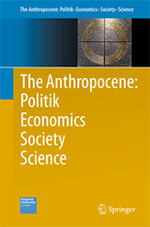
The Anthropocene
Politik – Economics – Society – Science (APESS))
Edited by
Hans Günter Brauch,
AFES-PRESS, chairman
Free University of Berlin (Ret.)
A Peer Reviewed Book Series
ISSN: (Print)
ISSN: (Online)

See here for a list of obituaries and Nachrufe
APESS
Vol 01 |
Paul J. Crutzen and the Anthropocene: A New Epoch in Earth’s History.
Editors: Benner, S., Lax, G., Crutzen, P.J., Pöschl, U., Lelieveld, J., Brauch, H.G.
ISBN: 978-3-319-43765-1 (Softcover)
ISBN: 978-3-319-43766-8 (EBook)
Doi: 10.1007/ 978-3-319-43766-8 (add chapter no.)
Order this book on Springer Website
|
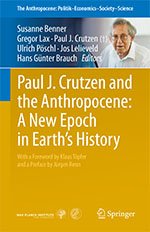 |
|
| |
- Presents a comprehensive collection of articles on the Anthropocene
- Collects unique primary research literature
- Provides reflections on the Anthropocene and its implications
About this book
This book outlines the development and perspectives of the Anthropocene concept by Paul J. Crutzen and his colleagues from its inception to its implications for the sciences, humanities, society and politics. The main text consists primarily of articles from peer-reviewed scientific journals and other scholarly sources. It comprises selected articles on the Anthropocene published by Paul J. Crutzen and a selection of related articles, mostly but not exclusively by colleagues with whom he collaborated closely.
- In the year 2000 Nobel Laureate Paul J. Crutzen proposed the Anthropocene concept as a new epoch in Earth’s history
- Comprehensive collection of articles on the Anthropocene by Paul J. Crutzen and his colleagues
- Unique primary research literature and Crutzen’s comprehensive bibliography
- Paul Crutzen’s scientific investigations into human influences on atmospheric chemistry and physics, the climate and the Earth system, leading to the conception of the Anthropocene
- Reflections on the Anthropocene and its implications
- Bibliometric review of the spread of the use of the Anthropocene concept in the Natural and Social Sciences, Humanities and Law
About the authors
Dr. Susanne Benner is head of communications at the Max Planck Institute for Chemistry in Mainz since 2011. She studied biology at the RWTH Aachen University in Germany and obtained a Ph.D. time in organic chemistry at the Swiss Federal University Zurich (ETHZ).
Dr. Gregor Lax is a research scholar at the Max Planck Institute for the History of Science in Berlin. With a PhD from University of Bielefeld (2014), he worked at the Max-Planck-Institute for Chemistry and for the German Council for Science and Humanities (Wissenschaftsrat).
Prof. Dr. Paul J. Crutzen (†) was a director at the Max Planck Institute for Chemistry in Mainz. He received the Nobel Prize in Chemistry in 1995 for his work on ozone depletion. He addressed the Nuclear Winter in the 1980s and coined the Anthropocene concept in 2000.
Prof. Dr. Ulrich Pöschl is director of the Multiphase Chemistry Department at the Max Planck Institute for Chemistry and professor at the Johannes Gutenberg University in Mainz. He studied chemistry at the TU of Graz, Austria, and he worked at the Massachusetts Institute of Technology, at the Max Planck Institute for Chemistry, and at the TU of Munich.
Prof. Dr. Jos Lelieveld studied natural sciences Leiden Univ. (1984), obtained a PhD in Physics and Astronomy Utrecht Univ. (1990), was Prof. of Atmospheric Physics and Chemistry Univ. of Wageningen and Utrecht (1993-2000). Since 2000 he is Director and Scientific Member at the Max Planck Institute for Chemistry and Professor in Atmospheric Physics, University of Mainz.
PD Dr. Hans Günter Brauch taught as an Adj. Prof. international relations at the Free University of Berlin, he has been chairman of Peace Research and European Security Studies (AFES-PRESS) since 1987 and of the board of the HGB Foundation on Peace and ecology in the Anthropocene (HGBS) since 2000 and editor of five book series with Springer Nature.
See here also the previous book and on his other book publications:
|
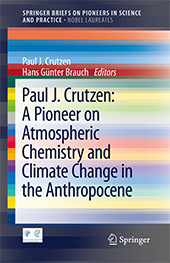 |
Paul J. Crutzen, Hans Günter Brauch (Eds.): Paul J. Crutzen: A Pioneer on Atmospheric Chemistry and Climate Change in the Anthropocene. Springer Briefs on Pioneers in Science and Practice No. 50 (Cham: Springer International Publishing, 2016).
ISBN (Print): 978-3-319-27459-1
ISBN (Online/eBook): 978-3-319-27460-7
DOI: 10.1007/978-3-319-27460-7
Order this book on the Springer Website
|
On the Author Paul J. Crutzen
|
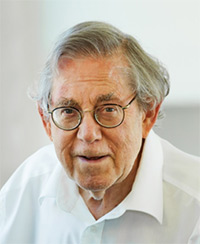
© Carsten Costard, Mainz/Germany |
The research of Paul J. Crutzen has been mainly concerned with the role of chemistry in climate and biogeochemistry, and in particular the photochemistry of ozone in the stratosphere and troposphere. In 1970 he hypothesized that natural ozone production by the action of solar ultraviolet radiation on molecular oxygen (O2) is mainly balanced by destruction processes, involving NO and NO2 as catalysts. These catalysts in turn result from the oxidation of N2O, a product of microbiological nitrogen conversion in soils and waters. He and Prof. Harold Johnston of the University of California, Berkeley, pointed out that NO emissions from large fleets of supersonic aircraft could cause substantial ozone losses in the stratosphere.
In 1979-1980 Crutzen and co-workers drew attention to the great importance of the tropics in atmospheric chemistry. In particular, some measurement campaigns in Brazil clearly showed that biomass burning in the tropics was a major source of air pollutants, on a par with, or larger than, industrial pollution in the developed world. In 1982 Crutzen, together with Prof. John Birks of the University of Colorado, drew attention to the risk of darkness and strong cooling at the earth surface as a consequence of heavy smoke production by extensive fires in a nuclear war (‘nuclear winter’). This study and additional studies by R. Turco, B. Toon, T. Ackerman, J. Pollack and C. Sagan and by the Scientific Committee on Problems of the Environment (SCOPE), to which Crutzen contributed, showed that more people could die from the indirect consequences of a nuclear war than by the direct impacts of the nuclear explosions.
In 1986, together with Dr. F. Arnold of the Max Planck Institute of Nuclear Physics in Heidelberg, Crutzen showed that nitric acid and water vapour could co-condense in the stratosphere at higher temperatures than required for water ice formation, providing a significant part of a chain of events leading to rapid ozone depletion at high latitudes during late winter and spring (the so-called Antarctic ‘ozone hole’). His most recent research is concerned with the role of clouds in atmospheric chemistry as well as photochemical reactions taking place in the marine boundary layer, involving catalysis by halogen gases produced by marine organisms. Also, his current research deals with the chemical and climatic effects of the heavy air pollution which is found over Asia and other regions in the developing world: the so-called ABC (Atmospheric Brown Clouds) phenomenon.
|
| |
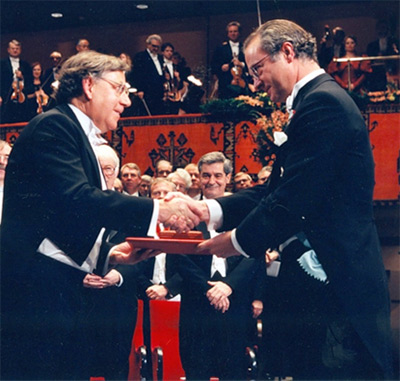
Stockholm, 10 December 1995 —
Paul Crutzen receives the Nobel Prize for Chemistry from Carl XVI Gustaf, King of Sweden.
© Reportagebild represented by dana press photo a/s, Industrivej 1,
DK-6000 Kolding, Denmark which granted the permission to use it here. |
| |
The Nobel Prize in Chemistry in 1995
|
| The Royal Swedish Academy of Sciences has decided to award the 1995 Nobel Prize in Chemistry to Professor Paul Crutzen, Max Planck Institute for Chemistry, Mainz, Germany (Dutch citizen), Professor Mario Molina, Department of Earth, Atmospheric and Planetary Sciences and Department of Chemistry, MIT, Cambridge, MA, USA and Professor F. Sherwood Rowland, Department of Chemistry, University of California, Irvine, CA, USA for their work in atmospheric chemistry, particularly concerning the formation and decomposition of ozone. |
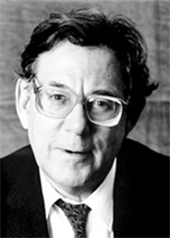
Paul J. Crutzen
Prize share: 1/3 |
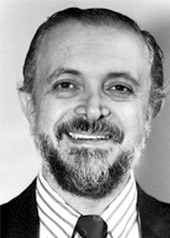
Mario J. Molina
Prize share: 1/3 |
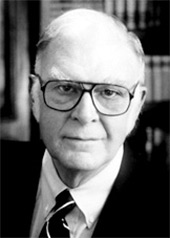
F. Sherwood Rowland
Prize share: 1/3 |
|
- Paul Crutzen was born in 1933 in Amsterdam. Dutch citizen. Doctor's degree in meteorology, Stockholm University, 1973. Member of the Royal Swedish Academy of Sciences, the Royal Swedish Academy of Engineering Sciences and Academia Europaea. Professor Paul Crutzen, Max Planck Institute for Chemistry, P.O. Box 3060 D-55020 Mainz, Germany.
- Mario Molina was born in 1943 in Mexico City, Mexico. PhD in physical chemistry, University of California, Berkeley. Member of the US National Academy of Sciences. Professor Mario Molina, Department of Earth, Atmospheric and Planetary Sciences MIT 54 – 1312, Cambridge MA 02139, USA
- F. Sherwood Rowland was born in Delaware, Ohio, USA, 1927 and deceased in 2012. Doctor's degree in chemistry, University of Chicago, 1952. Member of the American Academy of Arts and Sciences and of the US National Academy of Sciences, where he was Foreign Secretary.
Source: "Press Release: The 1995 Nobel Prize in Chemistry". Nobelprize.org. Nobel Media AB 2014. Web. 3 Jan 2015.
<http://www.nobelprize.org/nobel_prizes/chemistry/laureates/1995/press.html > and at: <http://www.nobelprize.org/nobel_prizes/chemistry/laureates/1995/illpres/reading.html>
and for the Award Ceremony Speech by Professor Ingmar Grenthe of the Royal Swedish Academy of Sciences is at:
<http://www.nobelprize.org/nobel_prizes/chemistry/laureates/1995/presentation-speech.html>. |
| |
 |
Interview with Paul Crutzen by Astrid Gräslund at the meeting of Nobel Laureates in Lindau, Germany, June 2000. Paul Crutzen talks about family background, early education and interest in natural science; his work in the Institute of Meteorology in Stockholm (5:02); his discovery (6:55); the ozone layer (15:42); the Greenhouse Effect (19:10); ozone holes (23:43); and the consequences of a 'Nuclear winter' (27:09). See a Video of the Interview, 34 min., at: <http://www.nobelprize.org/mediaplayer/index.php?id=734>.
Prof. Paul J. Crutzen on the eve of his 80th birthday on 2 December 2013 at the symposium The Anthropocene
organized in his honour by the Max Planck Institute of Chemistry in Mainz. Photo by Carsten Costard who granted permission. |

On the Max Planck Institute for Chemistry
|
Aiming at an integral scientific understanding of chemical processes in the Earth System from molecular to global scales.
Current research at the Max Planck Institute for Chemistry in Mainz aims at an integral understanding of chemical processes in the Earth system, particularly in the atmosphere and biosphere. Investigations address a wide range of interactions between air, water, soil, life and climate in the course of Earth history up to today´s human-driven epoch, the Anthropocene: see at:.
Research at the Max Planck Institute for Chemistry has been at the forefront of science throughout its existence. Since the Institute’s foundation in 1912, three of its directors were awarded with the Nobel Prize for Chemistry: Richard Willstätter in 1915 for the revelation of the structure of chlorophyll and other plant pigments, Otto Hahn in 1944 for the discovery of nuclear fission, and Paul Crutzen in 1995 for the elucidation of atmospheric ozone chemistry.
The research departments and focal points of the Institute have gone through a history of change and scientific evolution. What began in 1912 with classical organic, inorganic and physical chemistry at the Kaiser Wilhelm Institute for Chemistry in Berlin evolved into radiochemistry and nuclear physics in the 1930s, leading to the discovery of nuclear fission by Otto Hahn, Lise Meitner and Fritz Strassmann.
As the Institute was severely damaged towards the end of World War II it was moved to the Swabian Alps in today’s Baden-Wuerttemberg. There the chemists worked provisionally from 1944 to 1949 until the Institute moved a second time to the campus of the newly founded Johannes Gutenberg University in Mainz. At the same time it was integrated into the Max Planck Society, the successor of the Kaiser Wilhelm Society, Institute for Chemistry. Since 1959 the Institute also carries the epithet “Otto Hahn Institute” in honor of its previous director and the first president of the Max Planck Society.
In the 1960s and 1970s the Institute’s research portfolio was extended from Physical Chemistry, Nuclear Physics and Mass Spectrometry to Cosmochemistry, Isotope Cosmology and Air Chemistry. Meteorites and moon dust samples were studied and the interplay of atmospheric gases, particles and meteorology were investigated. In the 1980s new departments for Geochemistry and Biogeochemistry were founded, in 2001 the Particle Chemistry department was established jointly with the Institute for Atmospheric Physics at the Johannes Gutenberg University of Mainz. In 2012 the Multiphase Chemistry Department and in 2015 the Climate Geochemistry Department was founded.
Nowadays, the research focus of the Max Planck Institute for Chemistry is on Earth System science, in particular on the chemical processes occurring in the atmosphere and their interactions with the biosphere and oceans. It also includes the influence of humans, as unprecedented urbanization and industrialization in the past centuries have changed the course of natural processes on our planet, in an epoch now known as the Anthropocene.
Currently, the institute employs some 300 staff in four departments
Scientists conduct laboratory experiments, collect samples and record measurement data during field campaigns utilizing airplanes, ships, and vehicles. The practical work is complemented with mathematical models that simulate chemical, physical, and biological processes from molecular to global scales. One of the major goals is to find out how air pollution, including reactive trace gases and aerosols, affect the atmosphere, biosphere, climate, and public health. |
|
|
|